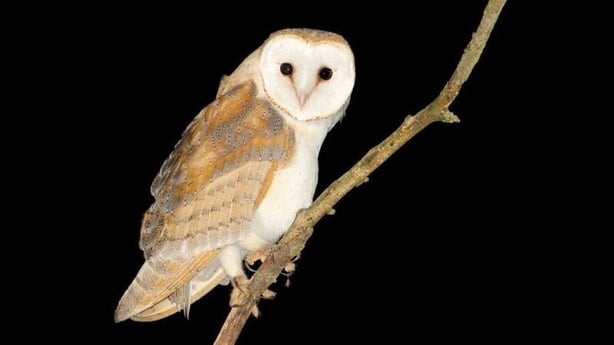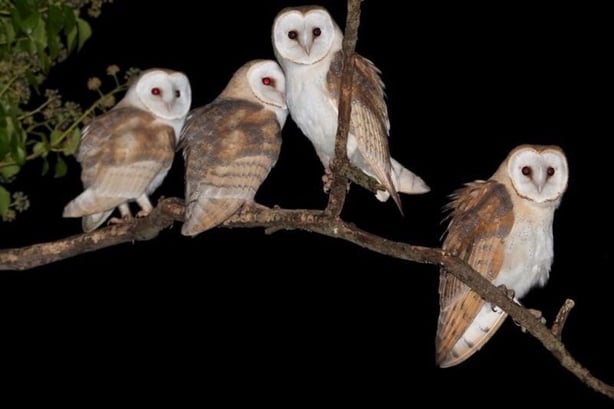Barn owl: Tyto alba (Latin name)
Scréachóg reilige (Irish name)

Photo - Brian Doyle
This is probably the best known and most widely distributed owl found in Ireland. The other two owls are the Long-eared owl and the Short-eared owl. It is often referred to as the Hissing owl or Death owl or Church owl or Ghost owl or White owl or Screech owl. All these names help us understand the biology of this particular owl. It is white underneath and its upper parts are an orange-buff colour. It has a large white flat-face with a heart-shaped facial disc. It is very ghostly looking and is commonly seen in graveyards. It gives a very eerie, drawn out screech, often while in flight and hence the Irish name, Scréachóg reilige which means graveyard screecher.
Sadly the numbers of Barn owls have been decreasing in Ireland over the last number of years. It is believed that the number has dropped to about 150 breeding pairs. This is due to a number of factors including a reduction of nesting sites and and an increase in the number of birds poisoned.
Barn owls feed on small mammals including shrews, mice and voles. They hunt over rough grassy areas, bogland, farmland and young forestry plantations. They hunt mainly by sound, rather than sight. The ears are set asymmetrical under the feathers and they have extremely accurate hearing. Rodents make up more than 90% of their diet. They swallow their prey whole and regurgitate the indigestible bits as a pellet. They mark out their territory with a wild screech, often while flying. A recent study has shown the presence of a new mammal species in Ireland. This is the Greater White-toothed Shrew and it was initially discovered through skull and bones found in owl pellets in Co. Tipperary. The introduction of this small mammal is probably good news for the Barn owl as it will provide another food source, not previously available to it.

Photo - Brian Doyle
Courtship normally begins in February and nest sites are commonly used time and time again. They often nest in holes of trees. Four to seven eggs are laid and these hatch after about 33 days. After this the young stay in the nest for another 2 months or more before fledging.
Although the Barn owl is a nocturnal owl, during the breeding season it can sometimes be seen early in the morning and late in the afternoon when the male needs to hunt for food which is needed for the brooding female and young in the nest.
An unusual thing about the Barn owl is that it doesn't hoot, it screeches instead. The ears of the Barn owl are located at different positions, thereby increasing sound reception. In flight, the left ear captures sound below, while the right ear focuses on sound from above.
It is generally quite difficult to tell males and females apart. Females may have darker upper surfaces and may have small black spots on the underside. Females may also be slightly larger than males.
Barn owls have very long legs, toes and talons. This enables them to catch prey at the bottom of deep vegetation. The talons are extremely sharp and the prey is thought to be killed by foot clenching rather than a peck.
QUESTIONS:
1. What is the Irish name for the Barn owl?
2. How did the Barn owl get this Irish name?
3. Why is it sometimes called the Death owl?
4. What do barn owls normally feed on?
5. Where would you normally find barn owls?
6. What is Ireland’s newest mammal species called?
7. Do Barn owl’s hoot?
8. How can you tell a male barn owl from a female one?
9. What is so special about the position of the barn owl’s ears?
10. How do barn owls kill their prey.
